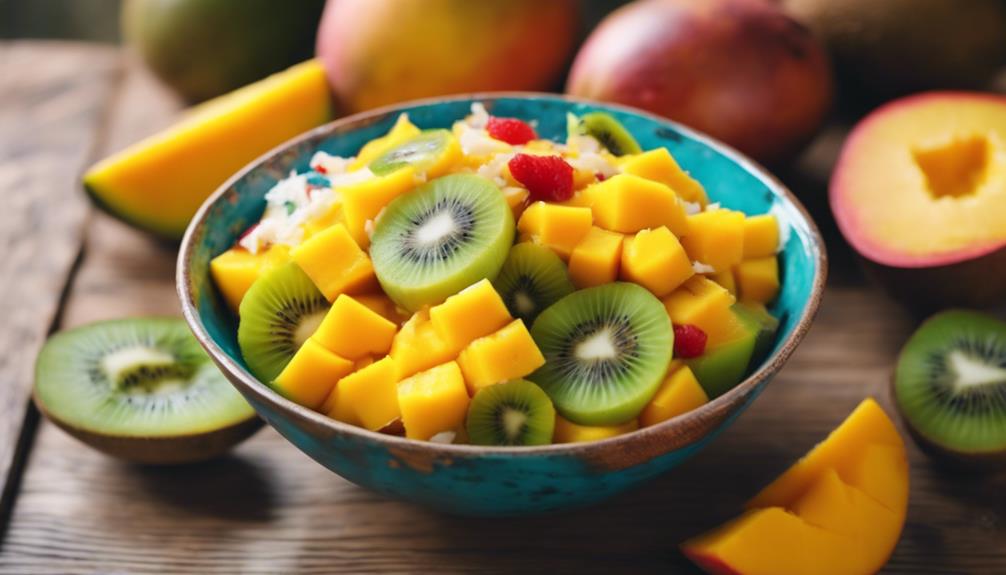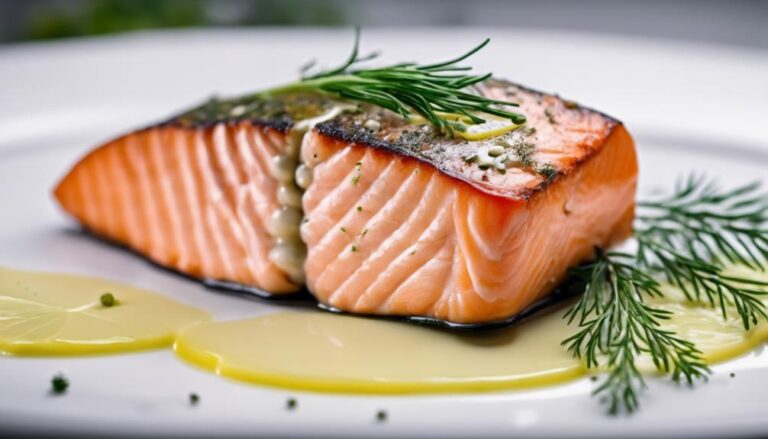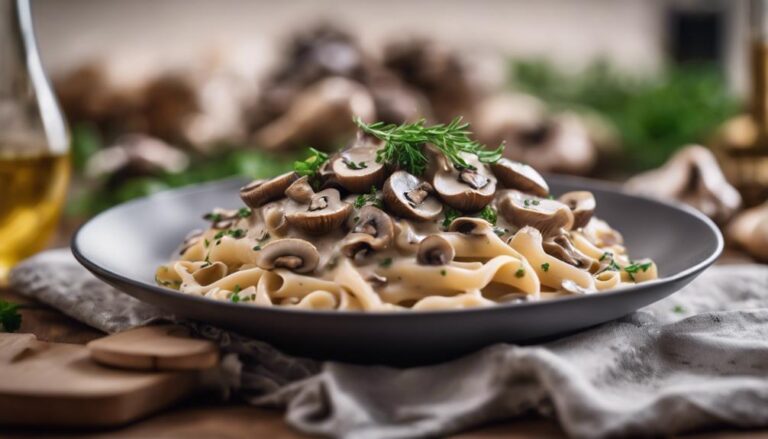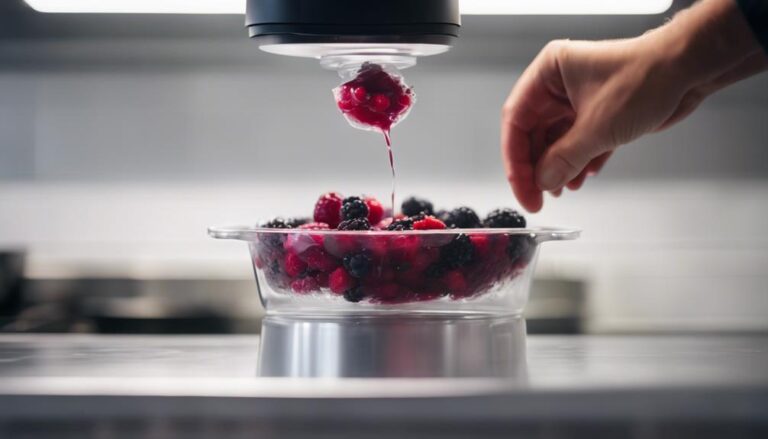Tropical Mango Medley
Immerse yourself in the delectable Tropical Mango Medley, a delightful blend of fresh mangoes that will transport your taste buds to a tropical paradise. This vibrant dish offers a symphony of exotic flavors in every spoonful, showcasing the versatility and sweetness of this beloved tropical fruit. Let each bite tantalize your senses with the natural goodness and bright hues of mangoes, providing a burst of freshness and satisfaction in every mouthful. If you want to uncover more about the origins and varieties of mangoes, as well as learn additional mouth-watering mango recipes, there's a world of tropical culinary exploration waiting for you.
What You Will Learn Here
- Tropical Mango Medley combines fresh mangoes with other tropical fruits
- Offers a burst of flavors and vibrant colors in a refreshing dish
- Easy to prepare and perfect for summer gatherings or as a dessert
- Provides a mix of sweet, tangy, and tropical tastes in every bite
- Versatile dish that can be customized with additional ingredients or served as is
Origins of Mangoes

Mangoes have a rich history as tropical fruits. Different varieties of mangoes offer unique tastes and textures.
The cultivation process involves specific methods for growing these delicious fruits.
Mangoes: Tropical Fruit History
Originating in South and Southeast Asia, the mango has a rich history as a tropical fruit. Believed to have been cultivated for over 4,000 years, mangoes were initially grown in India and gradually spread to other regions like the Philippines, Malaysia, and East Africa through trade and migration.
Mangoes hold cultural significance in many societies, often symbolizing prosperity, love, and even immortality in certain mythologies. They were introduced to the Americas by Portuguese explorers in the 16th century, and today, countries like India, China, Thailand, and Indonesia are among the top producers of this delicious fruit.
The mango tree, scientifically known as Mangifera indica, can grow up to 100 feet tall and produces an abundance of sweet and juicy fruits. With over 1,000 different varieties worldwide, each offering a unique taste, texture, and color, mangoes have become a staple in cuisines around the globe. From the creamy Alphonso mango to the fiber-free Kent mango, this diverse fruit continues to captivate taste buds and inspire culinary creations.
Mango Varieties: Different Types
Exploring the diverse world of mango varieties reveals a vibrant tapestry of flavors and origins. Mangoes, often referred to as the 'king of fruits,' originated in South Asia thousands of years ago. The most common variety, the Alphonso mango, hails from India and is known for its sweet, rich taste and vibrant orange color. Another popular type is the Ataulfo mango, originating from Mexico, with its creamy texture and honey-like sweetness. The Haden mango, a Floridian native, offers a perfect balance of sweetness and tartness.
Moving to Southeast Asia, the Nam Doc Mai mango from Thailand stands out for its elongated shape and tropical aroma. The Keitt mango, grown in the United States, is celebrated for its lack of stringiness and invigorating taste. In the Caribbean, the Julie mango is cherished for its small size, fiberless flesh, and intense sweetness. As you savor these different mango varieties, you also taste the unique regions and climates where they originated, each adding its own twist to the delightful mango medley.
Mango Cultivation: Growing Process
As you admire the diverse array of mango varieties with their unique flavors and origins, understanding the process of mango cultivation reveals the intricate journey from seed to fruit. Mangoes are believed to have originated in South Asia over 4,000 years ago. The cultivation process begins with selecting the right type of mango seed, which is then planted in well-draining soil. Mango trees thrive in tropical climates with plenty of sunlight and regular watering.
After planting, it takes about two to four weeks for the mango seed to germinate. The young mango plant, known as a seedling, requires careful nurturing to guarantee healthy growth. As the seedling matures, it develops into a small tree that can bear fruit within three to six years, depending on the variety.
During the growing process, mango trees need proper care, including pruning, fertilizing, and pest control. As the mango fruits start to develop, they go through stages of growth until they're ready to be harvested. Understanding the cultivation process sheds light on the dedication and expertise required to produce the beloved tropical fruit.
Mango Varieties
With a wide array of flavors and textures, mango varieties offer a delightful range of options for mango enthusiasts. Here are some popular mango varieties you might encounter:
- Alphonso: Known as the 'King of Mangoes,' the Alphonso variety is famous for its rich, sweet, and creamy texture. It's often considered one of the best-tasting mango varieties globally.
- Ataulfo: Also referred to as the Honey or Champagne mango, the Ataulfo mango is small, golden-yellow, and has a buttery smooth texture with a sweet and tangy taste. It's perfect for snacking and making desserts.
- Tommy Atkins: This variety is one of the most widely cultivated mangoes globally. It has a colorful red-green exterior and a mildly sweet flavor. Tommy Atkins mangoes are great for juicing and adding to salads.
Each mango variety has its unique characteristics, making it suitable for various culinary uses. Whether you prefer the intense sweetness of the Alphonso, the creamy texture of the Ataulfo, or the versatility of the Tommy Atkins, exploring different mango varieties can add a delightful twist to your culinary adventures.
Mango Delightful Dishes

Discover the endless possibilities of mango-infused dishes with our featured recipes.
From the zesty Mango Salsa to the creamy Mango Coconut Smoothie and the indulgent Mango Sticky Rice, there's a delightful mango creation for every taste bud.
Let's commence on a culinary journey filled with the sweet and tropical flavors of this versatile fruit.
Mango Salsa Recipe
Get ready to elevate your taste buds with this tantalizing Mango Salsa Recipe from Mango Delightful Dishes. This vibrant and flavorful salsa is the perfect accompaniment to any dish, adding a invigorating tropical twist to your meals. Here's how you can make this delicious Mango Salsa at home:
- Ingredients:
- Ripe mangoes, diced
- Red onion, finely chopped
- Fresh cilantro, chopped
- Jalapeño, minced
- Lime juice
- Salt and pepper to taste
- Instructions:
- In a mixing bowl, combine the diced mangoes, chopped red onion, cilantro, and minced jalapeño.
- Squeeze fresh lime juice over the mixture and gently toss to combine.
- Season with salt and pepper to taste.
- Serve:
- Enjoy this Mango Salsa as a topping for grilled chicken or fish, as a dip with tortilla chips, or as a side to your favorite Mexican dishes. The sweetness of the mangoes combined with the heat of the jalapeño creates a harmonious flavor explosion that will leave you craving more.
Mango Coconut Smoothie
Indulge in the tropical bliss of Mango Coconut Smoothie, an invigorating blend of creamy coconut and luscious mango from Mango Delightful Dishes. This invigorating beverage is a perfect pick-me-up on a hot summer day. Here's why you should give this delightful smoothie a try:
- Nutrient-packed: This Mango Coconut Smoothie isn't only delicious but also nutritious. Packed with vitamins and minerals from fresh mango and coconut, it's a great way to boost your daily intake of essential nutrients.
- Easy to make: With just a few simple ingredients and a blender, you can whip up this heavenly drink in no time. Perfect for a quick breakfast or a rejuvenating snack, this smoothie is a hassle-free treat for your taste buds.
- Versatile: Customize your Mango Coconut Smoothie by adding extras like chia seeds, spinach, or protein powder. The versatility of this recipe allows you to experiment and create your own unique twist on this tropical classic.
Mango Sticky Rice Recipe
Sink your teeth into the delectable Mango Sticky Rice Recipe from Mango Delightful Dishes, a perfect blend of sweet mango and sticky rice that will transport your taste buds to tropical paradise. This traditional Thai dessert is a must-try for any mango lover. Here's why you should give it a go:
- Sweet and Creamy: The ripe mango slices on a bed of warm sticky rice drizzled with coconut milk create a symphony of flavors that's both sweet and creamy.
- Textural Delight: The chewy texture of the sticky rice complements the juicy mango, offering a delightful contrast that keeps you coming back for more.
- Simple Yet Exotic: Despite its simple ingredients, the Mango Sticky Rice Recipe manages to capture the exotic essence of tropical desserts, making it a delightful treat for any occasion.
Don't miss out on this heavenly dessert that brings a taste of the tropics right to your plate.
Mango Cooking Hacks
Discover efficient ways to handle mangoes in the kitchen with these mango cooking hacks.
Learn how to quickly slice a mango, test its ripeness, and effortlessly remove the seed.
These simple tricks will make working with mangoes a breeze and elevate your culinary creations.
Quick Mango Slicing
Slice your mango quickly and efficiently with these handy mango cooking hacks. To start, position your mango vertically on a cutting board. With a sharp knife, slice off each side of the mango, avoiding the large pit in the center. Then, take each mango half and make a crisscross pattern with your knife, being careful not to cut through the skin. Once you've done this, push the skin side up to invert the mango half, revealing the delightful mango cubes. Finally, use a spoon to scoop out the mango cubes or cut them off the skin for easy serving.
Another quick method is using a glass to separate the mango flesh from the skin. After cutting off the mango cheeks, take a glass and slide it between the flesh and skin, pressing downwards to separate. This technique allows you to enjoy your mango without worrying about intricate cutting or wasting any delicious fruit. With these simple tricks, you can slice your mango in no time, making it a breeze to add this tropical delight to your favorite dishes or enjoy it as a satisfying snack.
Mango Ripeness Test
To determine the ripeness of a mango, gently squeeze the fruit to gauge its firmness and aroma. A ripe mango should yield slightly to pressure but not be too soft. The skin color isn't always an indicator of ripeness, as some varieties stay green even when fully ripe.
In addition to firmness, a ripe mango will emit a sweet, fruity aroma near the stem end. If the mango feels rock hard and has no scent, it's likely unripe. On the other hand, if the mango is mushy and smells overly sweet, it may be overripe.
When selecting a mango for immediate consumption, go for one that gives slightly when pressed and releases a pleasant fragrance. Remember, a ripe mango is best for eating fresh or using in recipes, while an unripe one can be stored at room temperature to ripen over a few days.
Mango Seed Removal
Removing the seed from a mango can be made easier with a simple kitchen tool. To start, slice off both sides of the mango, avoiding the seed in the center.
Take one mango half in your hand, skin side down, and score the flesh in a crisscross pattern without cutting through the skin. Then, invert the mango half by pushing the skin side up so the cubes pop out, resembling a hedgehog.
Here comes the trick: take a glass or a cup with a thin rim and use it to scoop out the mango cubes from the skin. Press the rim against the skin, separating the ripe mango from the peel effortlessly. Repeat the process for the other mango half.
This method not only removes the seed efficiently but also provides you with neatly diced mango ready to be added to your favorite recipes, whether it's a delightful fruit salad, a tropical salsa, or a smoothie. Enjoy the sweet taste of mango without the hassle of dealing with the seed!
Final Thoughts
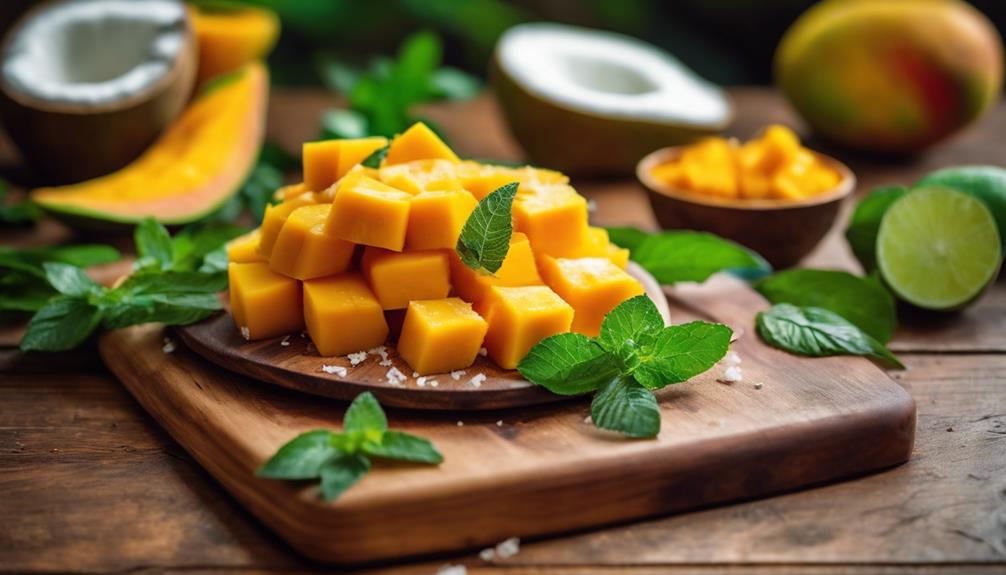
As you savor the last spoonful of this Tropical Mango Medley, reflect on the burst of flavors that danced on your taste buds throughout this delightful culinary journey. The sweet tanginess of the mangoes, the invigorating hint of lime, and the subtle kick of chili powder all came together in a harmonious symphony of taste. Each bite offered a new sensation, a new combination of flavors that kept you intrigued and satisfied.
In this final moment with your mango medley, take a moment to appreciate the versatility of this dish. It could be a vibrant side to a savory meal, a zesty topping for grilled fish, or a standalone dessert that leaves a lasting impression. The simplicity of the ingredients belies the complexity of the flavors they create when combined thoughtfully.
Consider the journey of creating this Tropical Mango Medley – from selecting the ripest mangoes to delicately balancing the seasonings. The care and attention put into each step have resulted in a dish that not only pleases your palate but also nourishes your soul with its vibrant colors and fresh ingredients.
As you finish your meal, remember that the joy of cooking lies not only in the end result but also in the process itself. Embrace the creativity, the experimentation, and the discovery that come with trying new recipes. And above all, continue to enjoy the simple pleasures that a delicious dish like this mango medley can bring to your table.
Frequently Asked Questions
Can Mangoes Be Grown in Non-Tropical Climates?
Yes, mangoes can be grown in non-tropical climates with proper care. Consider using greenhouse or indoor cultivation methods to create a suitable environment for mango trees. Regularly monitor conditions like temperature and humidity to guarantee success.
Are There Any Health Benefits Specific to Mangoes?
Sure, mangoes offer many health benefits. They are rich in vitamins, minerals, and antioxidants. Eating mangoes can boost your immune system, aid digestion, promote skin health, and may even help lower the risk of certain diseases.
How Can Mangoes Be Incorporated Into Skincare Routines?
To incorporate mangoes into your skincare routine, try making a DIY face mask with mashed mango and honey. This natural remedy can help hydrate your skin, boost collagen production, and brighten your complexion for a healthy glow.
What Is the Best Way to Store Ripe Mangoes?
To store ripe mangoes, place them in a paper bag at room temperature to ripen further. Once ripe, transfer them to the refrigerator to extend their shelf life. Keep them in a plastic bag to prevent excess moisture.
Are There Any Superstitions or Myths About Mangoes?
In many cultures, superstitions and myths about mangoes abound. From bringing good luck to symbolizing fertility, these beliefs have been passed down for generations. Keep exploring to uncover fascinating stories and traditions.
Conclusion
To sum up, mangoes are a versatile and delicious fruit that can be enjoyed in a variety of dishes. With different varieties to choose from, there's a mango for every taste preference.
Whether you prefer them fresh, in smoothies, or in savory dishes, mangoes can add a tropical touch to your meals. Remember to try out some cooking hacks to make the most of this flavorful fruit.
Enjoy exploring the world of mangoes and discovering new ways to incorporate them into your culinary creations.
